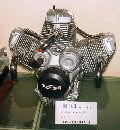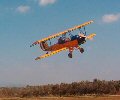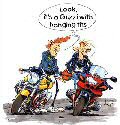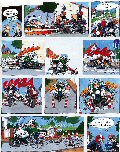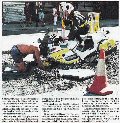Site: Danish | English
Technical : The complex stuff - exciting but heavy reading, take your time.
Fun stuff
Please contact Gregory Bender with any questions, corrections, or suggestions for improvement.
Fun stuff
This page contains motorcycle related humor, some about Guzzi, other are more general on bikes. Some are not bike related, but personal favorites. That will show you what a twisted mind I have.
If you have any materiel that will fit this page, please send it to me ("Feedback" button below).
Table of contents
- A beer a day.... - Yaeehhhh....
- About tools - don't get hurt.
- A rather special roundabout, located in England of course :-)
- Maintenance complaints - why precision is important.
- Moto Guzzi carburetor/injection patent from 1951.
- Sound or noise ? - depends of who's listening
- Strange Moto Guzzi projects - see what's possible .....
- To wave or not to wave - this one has a certain Honda bias, but its fun anyway - You meet the nicest people on a Honda
- US standard railroad gauge - Bureaucrats are forever.
- Various images
A beer a day.... - Yaeehhhh....
A herd of buffalo can only move as fast as the slowest buffalo. And when the herd is hunted, it is the slowest and weakest ones at the back that are killed first.
This natural selection is good for the herd as a whole, because the general speed and health of the whole group keeps improving by the regular killing of the weakest members.
In much the same way, the human brain can only operate as fast as the slowest brain cells. Excessive intake of alcohol, as we know, kills brain cells. But naturally it attacks the slowest and weakest brain cells first.
In this way, regular consumption of beer eliminates the weaker brain cells, making the brain a faster and more efficient machine.
That's why you always feel smarter after a few beers.
About tools - don't get hurt.
HAMMER: Originally employed as a weapon of war, the hammer nowadays is used as a kind of divining rod to locate expensive parts not far from the object we are trying to hit.
MECHANIC'S KNIFE: Used to open and slice through the contents of cardboard cartons delivered to your front door; works particularly well on boxes containing seats and motorcycle jackets.
ELECTRIC HAND DRILL: Normally used for spinning steel Pop rivets in their holes until you die of old age, but it also works great for drilling mounting holes in fenders just above the brake line that goes to the rear wheel.
PLIERS: Used to round off bolt heads.
HACKSAW: One of a family of cutting tools built on the Ouija board principle. It transforms human energy into a crooked, unpredictable motion, and the more you attempt to influence its course, the more dismal your future becomes.
VISE-GRIPS: Used to round off bolt heads. If nothing else is available, they can also be used to transfer intense welding heat to the palm of your hand.
OXYACETELENE TORCH: Used almost entirely for lighting various flammable objects in your garage on fire. Also handy for igniting the grease inside a brake drum you're trying to get the bearing race out of.
WHITWORTH SOCKETS: Once used for working on older British cars and motorcycles, they are now used mainly for impersonating that 9/16 or 1/2 socket you've been searching for the last 15 minutes.
DRILL PRESS: A tall upright machine useful for suddenly snatching flat metal bar stock out of your hands so that it smacks you in the chest and flings your beer across the room, splattering it against that freshly painted part you were drying.
WIRE WHEEL: Cleans rust off old bolts and then throws them somewhere under the workbench with the speed of light. Also removes fingerprint whorls and hard-earned guitar calluses in about the time it takes you to say, "Ouc...."
HYDRAULIC FLOOR JACK: Used for lowering a motorcycle to the ground after you have installed your new front disk brake setup, trapping the jack handle firmly under the front fender.
EIGHT-FOOT LONG DOUGLAS FIR 2X4: Used for levering a motorcycle upward off a hydraulic jack.
TWEEZERS: A tool for removing wood splinters.
PHONE: Tool for calling your neighbor to see if he has another hydraulic floor jack.
SNAP-ON GASKET SCRAPER: Theoretically useful as a sandwich tool for spreading mayonnaise; used mainly for getting dog-doo off your boot.
E-Z OUT BOLT AND STUD EXTRACTOR: A tool that snaps off in bolt holes and is ten times harder than any known drill bit.
TIMING LIGHT: A stroboscopic instrument for illuminating grease buildup.
TWO-TON HYDRAULIC ENGINE HOIST: A handy tool for testing the tensile strength of ground straps and brake lines you may have forgotten to disconnect.
CRAFTSMAN 1/2 x 16-INCH SCREWDRIVER: A large motor mount prying tool that inexplicably has an accurately machined screwdriver tip on the end without the handle.
BATTERY ELECTROLYTE TESTER: A handy tool for transferring sulfuric acid from a car battery to the inside of your toolbox after determining that your battery is dead as a doornail, just as you thought.
AVIATION METAL SNIPS: See hacksaw.
TROUBLE LIGHT: The mechanic's own tanning booth. Sometimes called a drop light, it is a good source of vitamin D, "the sunshine vitamin," which is not otherwise found under motorcycles at night. Health benefits aside, it's main purpose is to consume 40-watt light bulbs at about the same rate that 105-mm howitzer shells might be used during, say, the first few hours of the Battle of the Bulge. More often dark than light, its name is somewhat misleading.
PHILLIPS SCREWDRIVER: Normally used to stab the lids of old-style paper-and-tin oil cans and splash oil on your shirt; can also be used, as the name implies, to round off Phillips screw heads.
AIR COMPRESSOR: A machine that takes energy produced in a coal-burning power plant 200 miles away and transforms it into compressed air that travels by hose to a Chicago Pneumatic impact wrench that grips rusty bolts last tightened 40 years ago by someone in Sindelfingen, and rounds them off.
PRY BAR: A tool used to crumple the metal surrounding that clip or bracket you needed to remove in order to replace a 50 cent part.
HOSE CUTTER: A tool used to cut hoses 1/2 inch too short.
A rather special roundabout, located in England of course :-)
Imagine that you're driving in England, concentrating on driving correctly in the left hand side of the road, and you meet a sign like this !
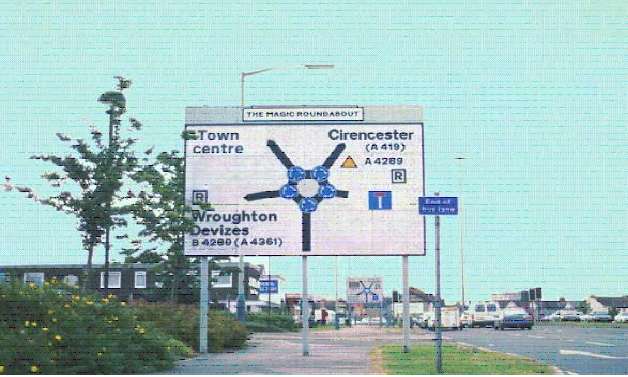
and you ask yourself - what is this?
After a short time you're in the middle of this ...
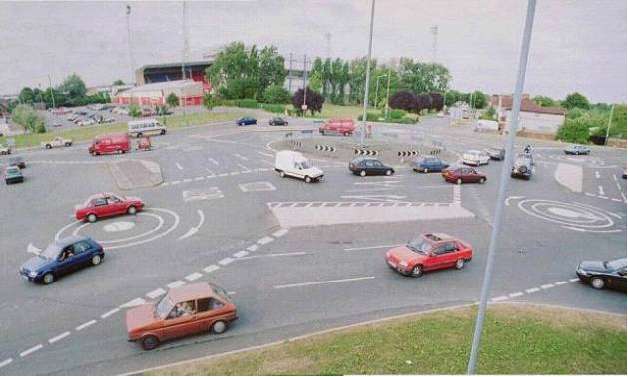
Do you know where to go??
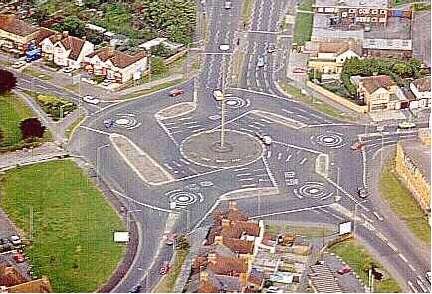
In England there are four of these roundabouts.
No wonder God put the English on their own island......
Maintenance complaints - why precision is important.
Here are some actual maintenance complaints submitted by US Air Force pilots, and the replies from the maintenance crews.
Problem : Left inside main tyre almost needs replacement.
Solution : Almost replaced left inside main tyre.
Problem : Test flight OK, except autoland very rough.
Solution : Autoland not installed on this aircraft.
Problem : The autopilot doesnt.
Solution : IT DOES NOW.
Problem : Something loose in cockpit.
Solution : Something tightened in cockpit.
Problem : Evidence of hydraulic leak on right main landing gear.
Solution : Evidence removed.
Problem : DME volume unbelievably loud.
Solution : Volume set to more believable level.
Problem : Dead bugs on windscreen.
Solution : Live bugs on order.
Problem : Autopilot in altitude hold mode produces a 200 fpm descent.
Solution : Cannot reproduce problem on ground.
Problem : IFF inoperative.
Solution : IFF inoperative in OFF mode.
Problem : Friction locks cause throttle levers to stick.
Solution : Thats what they're there for.
Problem : Number three engine missing.
Solution : Engine found on right wing after brief search.
Moto Guzzi carburetor/injection patent from 1951.
The drawing below shows the principle of a "new" carburetor/injection system that Moto Guzzi patented in 1951. I have no idea If it has ever been tested in a real live engine.
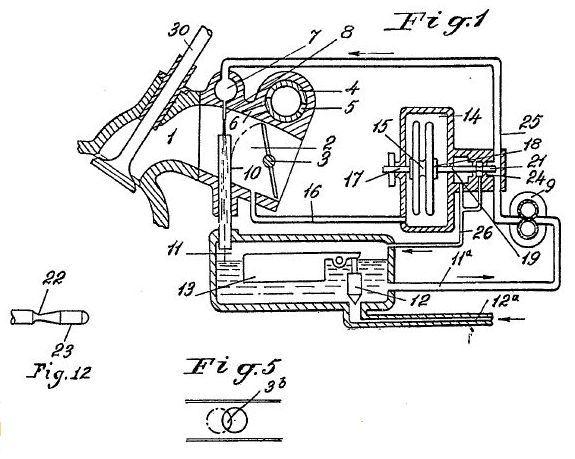
It works like this:
- The pump (9) flows the fuel from the float chamber to the nozzle (6) and returns it through the pipe (10) to the float chamber.
- The velocity of the air being sucked through the inlet port is not big enough to bend the stream of fuel from the nozzle and take it into the engine.
- The hollow shaft (4) is made to rotate at the same speed as the cam and the hollow part of the shaft is supplied with pressurized air from an external pump.
- The shaft is timed to make the hole (5) align with the bore (6) when the inlet valve (30) is open.
- Note that the bore is directed towards the stream of fuel. The pressurized air that now flows through the shaft, hole, and bore has enough power to bent the stream of fuel and vaporize it to make an ignitable mixture flow into the combustion chamber.
- The amount of pressurized air is increased with the speed of the engine by "pushing" the shaft in its length direction, thereby increasing the open gap between the hole and the bore (Fig. 5)
- You will also find an automatic system compensating for the pressure variation in the inlet duct (14+15+17 and other).
It should work theoretically, and must have involved a lot of human brain activity - note that this was made long before computers existed. If it works in real life is quite another issue. We might never know......
To see the original patent document with more pictures click here. (.pdf format - 618 KB). Unfortunately the text is in Danish, but the pictures are international :-)
Sound or noise ? - depends of who's listening
This story has been told in different versions, but the essence is this:
An Italian Moto Guzzi engineer accompanied a brand-new motorcycle to the U.S. for its debut.
When he started up the bike and it began to sing that sweet, classic mechanical opera only a Guzzi can produce, a doubtful reporter asked in a snide way what that "noise" was.
After an astounded pause, the engineer blurted out in his wonderful accent, "Datsa notta noise, eetsa sound!"
We think he was absolutely right.
Strange Moto Guzzi projects - see what's possible .....
Have a look at Charles Guzzi engined Lomax car
Other strange Moto Guzzi projects
To wave or not to wave - this one has a certain Honda bias, but its fun anyway - You meet the nicest people on a Honda
I love motorcycles, and I love riding. Like many of you, what first drew me to bikes was not just the experience of riding, but the feeling that I'd become part of a special community—a brotherhood, really. Nothing calms me more than a long ride down the interstate, waving to the members of my beloved clan. Except when I pass Harley guys. I hate Harley guys. Hate, hate, hate. When they pass me on the highway, you know what I do? I don't wave. With their little tassle handlebars and the studded luggage and the half-helmets--God, they drive me crazy.
You know who else I hate? BMW guys. Oh, I do hate those guys. I don't wave at them, either. They think they're so great, sitting all upright, with their 180-degree German engines. God, I hate them. They're almost as bad as those old bastards on their touring motorcycles. You know what I call those bikes? "Two-wheeled couches!" Get it? Because they're so big. They drive around like they've got all day. Appreciate the scenery somewhere else, Grampa, and while you're at it, I'm not waving to you.
Ducati guys--I don't wave at them either. Why don't they spend a little more money on their bikes? "You can have it in any color you want, as long as it's red." Aren't you cool! Like they even know what a desmo-whatever engine is, anyway. Try finding the battery, you Italian-wannabe racers! I never, ever wave at those guys.
Suzuki guys aren't much better, which is why I never wave at them, either. They always have those stupid helmets sitting on top of their stupid heads, and God forbid they should wear any safety gear. They make me so mad. Sometimes they'll speed by and look over at me and you know what I do? I don't wave. I just keep on going.
Please, don't get me started on Kawasaki guys. Ninjas? What are you, twelve years old? Team Green my ass. I never wave at Kawasaki guys.
I ride a Honda, and I'll only wave at Honda guys, but even then, I'll never wave at a guy in full leathers. Never, never, never. Yeah, like you're going to get your knee down on the New York Thruway. Nice crotch, by the way. Guys in full leathers will never get a wave from me, and by the way, neither will the guys in two-piece leathers. And I'll tell you who else I'm not waving at -- those guys with the helmets with the loud paintjobs. Four pounds of paint on a two pound helmet - like I'm going to wave back to that! I'll also never wave at someone with a mirrored visor. Or helmet stickers. Or racing gloves. Or hiking boots. To me, motorcycling is a like a family, a close-knit brotherhood of people who ride Hondas, wear jeans and a leather jacket (not Vanson) with regular gloves and a solid-color helmet with a clear visor, no stickers, no racing gloves and regular boots (not Timberlands). And isn't that what really makes riding so special?
US standard railroad gauge - Bureaucrats are forever.
The US Standard railroad gauge (distance between the rails) is 4 feet, 8.5 inches. That's an exceedingly odd number. Why was that gauge used? Because that's the way they built them in England, and the US railroads were built by English expatriates.
Why did the English people build them like that? Because the first rail lines were built by the same people who built the pre-railroad tramways, and that's the gauge they used.
Why did they use that gauge then? Because the people who built the tramways used the same jigs and tools that they used for building wagons, which used that wheel spacing.
Okay! Why did the wagons use that odd wheel spacing? Well, if they tried to use any other spacing the wagons would break on some of the old, long distance roads, because that's the spacing of the old wheel ruts.
So who built these old rutted roads? The first long distance roads in Europe were built by Imperial Rome for the benefit of their legions. The roads have been used ever since.
And the ruts? The initial ruts, which everyone else had to match for fear of destroying their wagons, were first made by Roman war chariots. Since the chariots were made for or by Imperial Rome they were all alike in the matter of wheel spacing.
Thus, we have the answer to the original question. The United States standard railroad gauge of 4 feet, 8.5 inches derives from the original specification for an Imperial Roman army war chariot. Specs and Bureaucracies live forever.
So, the next time you are handed a specification and wonder what horse's ass came up with it, you may be exactly right. Because the Imperial Roman chariots were made to be just wide enough to accommodate the back ends of two war horses.
Now the twist to the story. . . .
There's an interesting extension of the story about railroad gauge and horses' behinds. When we see a Space Shuttle sitting on the launch pad, there are two big booster rockets attached to the sides of the main fuel tank. These are the solid rocket boosters, or SRBs. The SRBs are made by Thiokol at a factory in Utah. The engineers who designed the SRBs might have preferred to make them a bit fatter, but the SRBs had to be shipped by train from the factory to the launch site. The railroad line to the factory runs through a tunnel in the mountains. The SRBs had to fit through that tunnel. The tunnel is slightly wider than a railroad track, and the railroad track is about as wide as two horses' behinds.
So a major design feature of what is arguably the world's most advanced transportation system was determined by the width of a horse's ass!
Various images
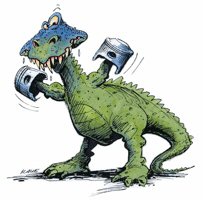
Guzzilla, an angry little guy.

No parking tickets.

just for fun !
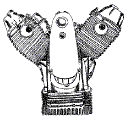
more fun !








